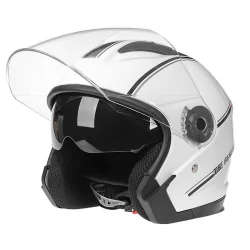Components of a typical motorcycle helmet
2023-11-13
A motorcycle helmet is a protective headgear specifically designed for motorcycle riders to minimize the risk of head injuries during accidents or collisions. Helmets are a critical piece of safety equipment for motorcyclists, as the head is vulnerable in the event of a crash.
Here are some key features and components of a typical motorcycle helmet:
1. Outer Shell: The outer shell is the hard, outer layer of the helmet, usually made of materials such as fiberglass, carbon fiber, or polycarbonate. It provides structural integrity and protection against impact.
2. Impact-Absorbing Liner: Inside the outer shell, there is a layer of impact-absorbing material, typically made of expanded polystyrene (EPS) foam. This liner is designed to absorb and disperse the energy generated during an impact.
3. Comfort Padding: The interior of the helmet is lined with soft, comfortable padding to provide a snug and secure fit. This padding also helps in wicking away sweat and enhancing overall comfort during rides.
4. Chin Strap and D-Ring Closure: Helmets are equipped with a chin strap, often secured with a D-ring or other fastening mechanism, to ensure that the helmet stays securely on the rider's head.
5. Ventilation System: Many helmets feature ventilation openings and channels to allow air to flow through, keeping the rider cool and comfortable.
6. Face Shield or Visor: Helmets often come with a built-in face shield or visor to protect the rider's eyes from wind, debris, and insects. Some helmets also allow for the attachment of separate goggles.
7. Safety Standards: Helmets should comply with safety standards set by organizations such as the Department of Transportation (DOT), the European Economic Community (ECE), or the Snell Memorial Foundation. These standards ensure that helmets meet specific safety requirements.
When selecting a motorcycle helmet, it's crucial to choose one that fits properly and meets safety standards. A proper fit ensures that the helmet will provide maximum protection in the event of an accident. Additionally, helmets should be replaced after any significant impact or every few years, as they can degrade over time.
Remember that wearing a helmet is not just a matter of personal choice; in many places, it's a legal requirement for motorcycle riders. Always prioritize your safety and adhere to local regulations regarding helmet use.



